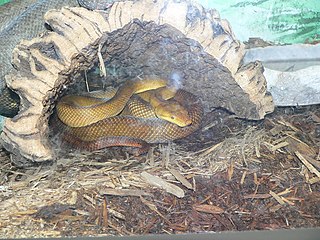
Echis coloratus, known as the painted saw-scaled viper, painted carpet viper, Burton's carpet viper, and by other common names, is a highly venomous viper species endemic to the Middle East and Egypt. No subspecies are currently recognized.

Morelia is a genus of large snakes in the family Pythonidae found in Indonesia, New Guinea, and throughout Australia. Currently, up to eight species are recognized.

Morelia spilota, commonly known as the carpet python, is a large snake of the family Pythonidae found in Australia, New Guinea, Bismarck Archipelago, and the northern Solomon Islands. Many subspecies are recognised; ITIS lists six, the Reptile Database six, and the IUCN eight.
The Christmas Island blind snake is a species of snake in the family Typhlopidae. The species is endemic to Christmas Island. There are no subspecies that are recognized as being valid.

Grypotyphlops acutus, also known as the beaked worm snake, beaked blind snake, or beak-nosed worm snake, is a harmless blind snake species endemic to peninsular India. It is the only species in the genus Grypotyphlops. No subspecies are currently recognized.

Acrochordus granulatus is a snake species found from India through Southeast Asia to the Solomon Islands. It is known as the little file snake, marine file snake, and little wart snake. It is completely aquatic and almost helpless on land. No subspecies are currently recognized.

Sanzinia madagascariensis, also known as the Madagascar tree boa or Malagasy tree boa, is a boa species endemic to the island of Madagascar. It was once considered conspecific with the Nosy Komba ground boa. Like all other boas, it is non-venomous.

Acrantophis dumerili, commonly known as Dumeril's boa, is a species of non-venomous snake in the family Boidae. The species is endemic to Madagascar. No subspecies are currently recognized.

Acrantophis madagascariensis is a species of boid snake in the subfamily Sanziniinae that is endemic to the island of Madagascar. Its common names include the Madagascar ground boa and Malagasy ground boa.

Acrochordus arafurae, known by the common names Arafura file snake, elephant trunk snake, and wrinkle file snake, is an aquatic snake species found in northern Australia and New Guinea. No subspecies are currently recognized.

Trimeresurus flavomaculatus is a venomous pit viper species endemic to the Philippines. Two subspecies are currently recognized, including the nominate subspecies described here.

Candoia bibroni, commonly known as Bibron's bevel-nosed boa, Bibron's keel-scaled boa, the Pacific tree boa, or the Fiji boa, is a boa species endemic to Melanesia and Polynesia. Two subspecies are recognized, including the nominate subspecies described here. Like all other boas, it is not venomous.

Ovophis okinavensis, commonly known as the hime habu (ヒメハブ), Ryukyu Island pit viper, and the Okinawan pitviper, is a venomous pitviper species found in the Ryukyu Islands of Japan. No subspecies are currently recognized.

Protobothrops elegans is a venomous pitviper species endemic to Japan in the southern Ryukyu Islands. No subspecies are currently recognized. Common names include: elegant pitviper, Sakishima habu (サキシマハブ), and elegant tree viper.

The elephant trunk snake or the Javan file snake, is a species of snake in the family Acrochordidae, a family which represents a group of primitive non-venomous aquatic snakes.
The Cairo blind snake is a species of nonvenomous snake in the family Leptotyphlopidae. The species is endemic to Africa.

Leptotyphlops distanti, also known commonly as Distant's thread snake or Distant's worm snake, is a species of snake in the family Leptotyphlopidae. The species is native to Southern Africa.

Epictia goudotii, also known commonly as the black blind snake and the southern Caribbean threadsnake, is a species of snake in the family Leptotyphlopidae. The species is endemic to Middle America.

Boulenger's blind snake is a species of snake in the family Leptotyphlopidae.
Anilios australis, or the southern blind snake, is a species of snake in the family Typhlopidae. The species is endemic to Australia.





















